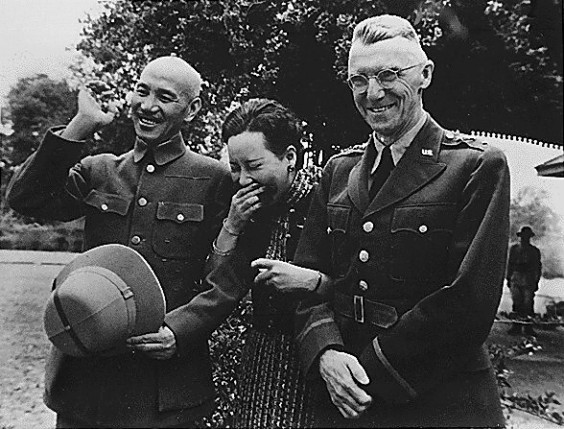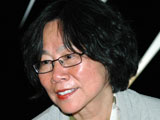“Where I Am, There Is Chinese Culture.”
by Tienchi Martin-Liao / October 14, 2015 / No comments

Wang Kang seeks to reveal the contributions of Chiang Kai-Shek (left) and his Nationalist Army during the Second Sino-Japanese War. Photo via Wikimedia Commons
Artist and scholar Wang Kang continues his fight to show the truth of the Second Sino-Japanese War, despite hostility from Beijing.
History has many faces; it all depends on how people interpret it. History can be covered up, distorted, and abused by a government to serve its political purposes. For instance, who led and fought the Anti-Japanese War between 1937 and 1945? Was it the Nationalist Army, under the leadership of Chiang Kai-shek, or the Chinese Communist Party with its Red Army? Through Chinese textbooks, children learn that Chiang’s Nationalist government sent its main forces to fight against the Communists, instead of resisting the Japanese invaders. Mao Zedong, we are told, won the war by inspiring the workers, peasants, and soldiers of the Red Army.

- During the Cultural Revolution, people were sentenced to death or outright murdered because of one wrong sentence. In China today writers do not lose their lives over their poems or articles; however, they are jailed for years. My friend Liu Xiaobo for example will stay in prison til 2020; even winning the Nobel Peace Prize could not help him. In prison those lucky enough not to be sentenced to hard labor play “blind chess” to kill time AND TO TRAIN THE BRAIN NOT TO RUST. Freedom of expression is still a luxury in China. The firewall is everywhere, yet words can fly above it and so can our thoughts. My column, like the blind chess played by prisoners, is an exercise to keep our brains from rusting and the situation in China from indifference.

- Tienchi Martin-Liao is the president of the Independent Chinese PEN Center. Previously she worked at the Institute for Asian Affairs in Hamburg, Germany, and lectured at the Ruhr-University Bochum from 1985 to 1991. She became head of the Richard-Wilhelm Research Center for Translation in 1991 until she took a job in 2001 as director of the Laogai Research Foundation (LRF) to work on human rights issues. She was at LRF until 2009. Martin-Liao has served as deputy director of the affiliated China Information Center and was responsible for updating the Laogai Handbook and working on the Black Series, autobiographies of Chinese political prisoners, and other human rights books. She was elected president of the Independent Chinese PEN Center in October 2009 and has daily contact with online journalists in China.
Yet, in recent years China has seen an attempt to restore the true historical facts. After all, with the increased flow of information there are many ways to approach the documents and archives outside China. Wang Kang, a grassroots scholar working out of Chongqing, has initiated a project to present the war against the Japanese in an unbiased way. Together with over 50 volunteer artists, writers, and scholars, Wang set out to create a painted scroll with integrated written text. It took the team over 8 years to finish the 1,610 square meter scroll, which features 838 historical figures that appear in real size.
The scroll, called the “Noble Long Stream” (haoqi changliu), was finished in 2009. Wang and his team received no government money for the project, rejecting offers from both China and Taiwan; the entire cost of 300 million RMB (472,000 USD) was raised through private donations. The scroll displays as an epic, split into five divisions. It begins with the Mukden Incident in 1931, continues through the eight-year-long war, and ends with the 1000 peace doves released in September 1945. The scroll includes the important historical figures in politics, military, culture, and diplomacy, both from the KMT and CCP, and even displays foreign characters such as Churchill, Roosevelt, Gandhi, Tolstoy, and Picasso. Yet the most vivid representations are those of the brave soldiers killed on the battlefield, and the suffering of the common people.
The massive artwork was unveiled in Taiwan on July 7, 2010, marking the 73rd anniversary of the Marco Polo Bridge Incident, when fighting began. On August 15, 2015, a duplicate of the piece was shown in Montgomery County, Maryland, for the 80th anniversary of Japan’s surrender. Three days before the exhibition, Mr. Wang, currently residing in Virginia, received a letter from the Chinese authorities. It read, “Stop the exhibition, return to China immediately. If you do not come back right away and continue the exhibition, you will not be able to return to your country anymore in the future.
Wang Kang grew up in hostile surroundings. His family faced discrimination and oppression due to their intellectual background. When he was born in 1949,Wang’s father was arrested because of his relationship with the Nationalists. Many years later, Wang Kang himself was also put into jail, accused of supporting the student demonstrations of 1989. The Chinese administration cannot tolerate anyone with strong opinions and will, and in the case of Wang Kang, his writings and the scroll project directly challenge the Party’s authority, even legitimacy. No wonder he got this warning. Mr. Wang’s response to the letter was quick and short: “No, sorry.”
I met with Wang Kang several weeks ago, before the exhibition. He lives alone in a small house that belongs to a friend in Fairfax, Virginia. He spends most of his days meditating and walking through the forest. This man lives in internal exile; his mind and thoughts are totally free, but they linger on his home country day and night as he tries to find a breakthrough to all the dilemmas troubling his nation. An authoritarian regime has no idea how to deal with this kind of citizen. The only solution is to “get rid of him,” and that’s what they did. Wang Kang is by no means an unworldly pedant though; he is strategic and clever. His scroll bares the signature of former KMT Party Chairman Lian Zhan, a Taiwanese politician who collaborated with the communist regime for years. Beijing used Lian as a bridge to Taiwan, and therefore treats him benevolently. With Lian as backup, the scroll could not only survive in China, but also been shown in Taiwan and now in the United States.
About his exile status, Wang Kang is neither sad nor worried. Like Thomas Mann once said upon arriving in New York after escaping from the Nazi regime, “Where I am, there is Germany.”
Wang Kang also said: “Where I am, there is Chinese culture.”




